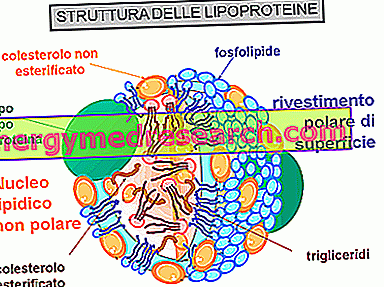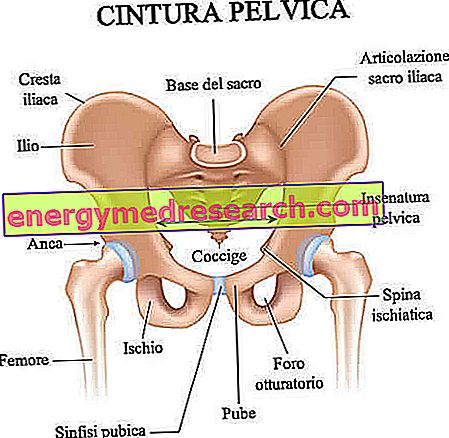Generality
The haemorrhagic corpus luteum is a disease that affects the ovaries. This condition represents the consequence of a cyst rupture, resulting from the abnormal dehiscence of a Graafian follicle, activated to mature an oocyte.

Ovary section, with follicles in development and corpus luteum in regression
In most cases, failure to reabsorb the cystic corpus luteum with blood content does not cause any symptoms and regresses spontaneously in a few weeks, without the need to be surgically removed. Sometimes, however, this mass reaches significant dimensions, causing acute pelvic pain, irregularity in the menstrual cycle, transient anemia and abdominal tension.
The haemorrhagic corpus luteum can rupture and cause a vaginal blood loss or a more or less important blood spill in the peritoneum. This last situation causes acute pain, similar to that of appendicitis and makes immediate medical intervention necessary. The rupture of the hemorrhagic corpus luteum can also cause nausea, vomiting and fever. Occasionally, a cystic formation with a diameter greater than 4 cm can get complicated with a twist of the ovary.
If the diagnosis is early, the condition can be treated to avoid serious consequences. The most used therapies for the hemorrhagic corpus luteum are mainly pharmacological. In severe cases, laparoscopy is used.
Menstrual cycle: key points
- From puberty to menopause, every month, the female body prepares for a possible pregnancy . If this does not happen, a new menstruation appears. The menstrual cycle has a variable duration between 21 and 35 days (on average it is 28 days).
- From the second day of the onset of menstruation, the so-called follicular phase begins: the follicles that lead to maturation of the egg cell are activated again, both to make the female gamete available, and to provide for the synthesis of the hormones (estrogen and progesterone) needed to reconstitute the endometrium.
- Around the 14th day ovulation occurs, a moment in the menstrual cycle in which fertilization can occur. After the release of the mature egg cell, the Graafian follicle is transformed into the corpus luteum, which produces progesterone, to predispose the inner wall of the uterus (endometrium) to the possible implant, if conception occurs ( luteal phase ).
What's this
The haemorrhagic corpus luteum is formed when, at the end of ovulation, the follicular cavity is occupied by a clot; when too much blood accumulates, a hematoma may develop.
The LUTEO BODY is a "temporary" endocrine gland that is formed during the luteinic phase of the menstrual cycle. This organism derives from the dehiscence of a Graafian follicle, activated to mature the egg cell inside the ovary.
Deprived of the oocyte and the liquid that fills the cavity, the structure that remains collapses, compressed by the surrounding tissues, giving rise to the corpus luteum. The latter is organized following the migration of connective cells coming from the vessels of the internal theca.
During this phase of vascularization of the corpus luteum, the residual cavity is occupied by a blood clot which is normally reabsorbed; meanwhile, the components of the organelle can complete their transformation into luteinic cells of granular origin (more numerous and responsible for the synthesis of progesterone) and tecale (estrogen producers) to carry out their endocrine function.
The term "corpus luteo" comes from the Latin "luteus", which means yellow. When it begins its regression, one of the elements that characterizes this organelle is, in fact, lutein, a yellowish substance (initially, the organelle is white-pinkish).
The corpus luteum has the task of producing progesterone (an hormone that is indispensable in the early stages of pregnancy) and, to a lesser extent, estrogen .
What is progesterone for?
The progesterone produced by the corpus luteum after ovulation predisposes the mucosa that internally covers the uterus (endometrium) to receive the implantation of a possible fertilized egg cell. This hormone is important, therefore, in the early stages of a pregnancy.
When conception does not occur, progesterone levels fall rapidly due to functional depletion of the corpus luteum. This triggers the phenomena that will lead to the exfoliation of the uterine wall and the subsequent menstruation. Otherwise, the fertilized egg cell nestles in the uterus, where it finds the most favorable environment for its implantation and the continuation of gestation.
The corpus luteum becomes hemorrhagic when an excessive amount of blood accumulates in the follicular cavity at the end of ovulation. In some cases, a hematoma is formed which induces ovarian enlargement, acute pelvic pain and, in case of rupture, vaginal and / or intraperitoneal blood loss.
Gravideal corpus luteum and menstrual corpus luteum
If the oocyte is not fertilized, within two weeks the corpus luteum moves independently towards the LUTEOLISI . This self-destruction is a scheduled process and at fixed time occurs due to the sharp decline in progesterone and estrogen levels, if the mature oocyte is not fertilized. Luteolysis can be suspended only with the intervention of a hormone called human chorionic gonadotropin, produced at the time of embryo implantation in the uterine cavity. If conception takes place, therefore, we speak of gravidic corpus luteum ; in this case, this specialized gland continues to secrete hormones up to the sixth month of gestation. The hormonal production by the corpus luteum continues until the natural "passing of baton" with the placenta occurs and the gravidic corpus lumps back, suffering atrophy.
When fertilization does not take place and a pregnancy does not take place, the corpus luteum is maintained in the ovary only for 12-13 days, before degenerating. Thus we speak of menstrual (or progestive) corpus luteum .
Causes
Normally, after ovulation - that is, following the release of the oocyte into the fallopian tube available for conception - the mature follicle collapses and forms the so-called LUTEO BODY . The latter consists of a "temporary" endocrine gland consisting of a mass of cells capable of producing the two main female hormones: progesterone (indispensable in the early stages of pregnancy) and, to a lesser extent, estrogen . When fertilization does not occur, after about two weeks from ovulation, this mass is autonomously destroyed; this event coincides with the appearance of menstruation.
If the egg is not fertilized and the corpus luteum does not undergo luteolysis, therefore it remains beyond the physiologically established time, cysts may be formed containing serous material ( cystic corpus luteum or lutein cyst ) or blood ( cystic luteal body ).
The haemorrhagic corpus luteum can have variable dimensions (3-10 cm) and different aspects (evidenced by ultrasound examination) based on the amount of blood present. The risk is that a hematoma develops with a consequent enlargement of the ovary.
Cystic corpus luteum
In addition to the hemorrhagic form, there is also the possibility that a cystic corpus luteum is created. In the latter case, when the corpus luteum does not carry out luteolysis, formations containing a serum-fibrinous exudate may form. The haemorrhagic corpus luteum differs from the cystic body mainly due to the presence of a variable-sized hemoperitoneum.
In most cases, lutein cysts do not cause symptoms and reabsorb spontaneously. However, their enlargement can cause pelvic discomfort, irregular and painful menstruation, nausea and fever. In the presence of such disorders it is advisable to contact your doctor promptly.
Risk factors
Some haemorrhages associated with the rupture of the corpus luteum have an unclear etiology, but there are recognized risk factors:
- Severe abdominal trauma;
- Anticoagulant therapy;
- Women of reproductive age (18-35 years).
Endometriosis can affect the physiological functioning of the ovary and disrupt the mechanisms of ovulation. In this sense, it can also facilitate the development of a hemorrhagic corpus luteum.
Symptoms and complications
In most cases, failure to reabsorb the cystic corpus containing blood does not cause any symptoms and tends to regress spontaneously within a few weeks.
If this mass reaches considerable dimensions, however, it can give rise to abdominal or pelvic pain, especially after a strenuous physical activity or sexual intercourse.
Other symptoms that indicate the presence of a hemorrhagic corpus luteum are:
- Changes in the menstrual cycle and / or amenorrhea;
- Soreness of the abdominal muscles;
- Pain during palpation of the abdominal and ovarian area.
In case of rupture, the haemorrhagic corpus luteum can cause a more or less important blood spill into the abdomen ( hemoperitoneum ). This may cause acute pain similar to that of appendicitis and requires immediate medical intervention.
Furthermore, rupture of the hemorrhagic corpus luteum can cause:
- Vaginal bleeding more or less abundant;
- Anemia;
- Nausea and / or vomiting;
- Temperature;
- Weakness;
- Syncope.
The haemorrhagic corpus luteum can be confused with other pathologies with many similar symptoms such as ectopic pregnancy, endometriosis and acute appendicitis.
In the event that conception has occurred, a pregnancy interruption may occur, if the activity of the corpus luteum is compromised by the cyst (ie it fails to produce an adequate amount of progesterone). When the lutein function is not altered, despite the presence of cystic formation, on the other hand, pregnancy can proceed without consequences.
Occasionally, a mass greater than 4 cm in diameter can get complicated with a twist of the ovary .
Diagnosis
The increase in the size of the hemorrhagic corpus luteum and the rupture of cystic formation can cause pelvic discomfort, irregular and painful menstruation, nausea and fever, as well as various other complications. For this reason, in the presence of such disorders, it is advisable to consult your doctor promptly to ascertain health conditions.
To diagnose the condition, vital signs are initially evaluated with a physical examination of the patient, such as fever and hemoglobin level in the event of bleeding.
The development of the hemorrhagic corpus luteum and of the extravasation of blood outside the cystic formation can be highlighted through an ultrasound examination . During the assessment, a differential diagnosis is important for lutein cysts and other ovarian neoformations (such as neoplastic lesions, dermoids and endometriotic cysts).
Another test that could be performed is the serum or urine pregnancy test ; in this case, there may be more serious problems and an ectopic gestation (outside the uterine cavity) should be excluded.
Urinalysis can be performed to identify, instead, urinary tract infections, kidney stones or bladder stones. When a cyst reaches very large dimensions, the possibility of ovarian torsion must also be assessed.
After diagnosis, the hemorrhagic corpus luteum can be monitored or treated to avoid serious consequences.
Treatment
Usually, the cystic corpus lute of haemorrhagic character is self-limiting and does not require any specific treatment. To document the resolution of the disease, it is likely that the patient will be kept under observation with serial ultrasound checks.
However, if there are disorders, it is important to go to your doctor, who can indicate the use of the most appropriate pharmacological or surgical therapies.
As for drugs, if the patient is stable, anti-haemorrhagic and analgesic drugs are usually prescribed. If the bleeding is continuous, the situation worsens or the patient is haemodynamically unstable, however, it is essential to intervene with a surgical operation .
In the presence of a hemorrhagic corpus luteum associated with signs of peritonitis, the removal of the formation by laparoscopy or laparotomy is necessary. Most bleeding can be interrupted by suturing, cauterization, cystectomy or cuneiform resection of the ovary.
When the problem tends to recur, the doctor can prescribe a pharmacological therapy based on ovariostatics, which can prevent the formation of the haemorrhagic corpus luteum and manages to limit its disturbances.



